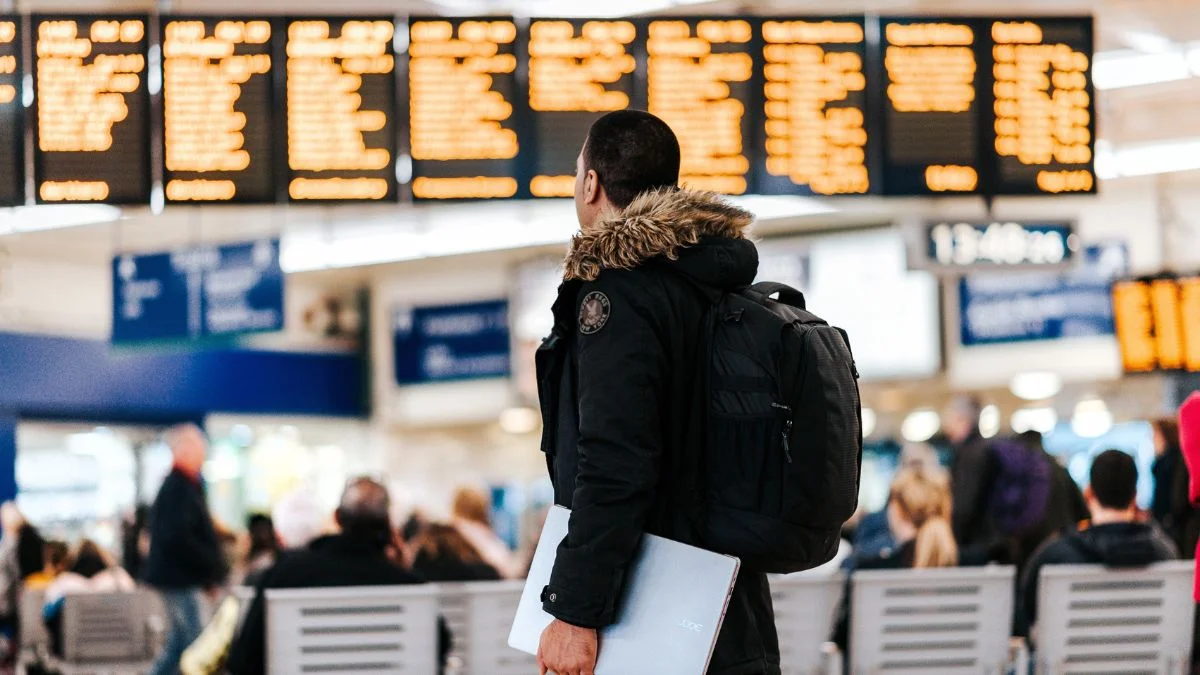How Early Can You Check Your Bags For A Flight?

As participants in Amazon Associates and other programs, we earn from qualifying purchases. This comes at no additional cost to you. For more details, see our Affiliate Disclosure.
Air travel can be a stressful experience, especially when it comes to checking in luggage. One of the most common questions travelers have is how early they can check their bags for a flight. The answer to this question can vary depending on several factors, including the airline, the airport, and the destination.
In this article, we’ll explore the different factors that can affect when you can check your bags for a flight and provide some tips for making the process as smooth as possible.
The Importance of Early Bag Check-In
Checking your bags early for a flight might seem like a mere matter of convenience, but in reality, it holds significance for both travelers and the airline operations.
- Avoiding Last-Minute Rush: Nobody enjoys the hustle and bustle of a crowded airport, especially when running against the clock. Checking your bags early can save you from the unnecessary stress of long queues and potential delays.
- Ensuring On-time Departures: Airlines operate on tight schedules. The timely check-in of luggage allows them to manage baggage logistics efficiently, ensuring that flights can leave on time. Late check-ins can delay flights, causing a cascade of problems for the airline and subsequent travelers.
- Safety and Security: Airports have a responsibility to screen all luggage for the safety of all passengers. Early baggage check-in provides ample time for thorough inspections, reducing the chances of security-related delays.
- Optimal Seat Choices and Upgrades: For many airlines, checking in early—whether online or at the counter—can sometimes result in better seat options or even complimentary upgrades, especially if there’s availability.
- Peace of Mind: Traveling can be overwhelming, especially during peak seasons. Knowing that your luggage is checked in and taken care of can provide a sense of relief, allowing you to enjoy other airport amenities or simply relax before the flight.
- Mitigating Unforeseen Circumstances: Sometimes, unexpected issues can arise, such as problems with baggage weight or size. Early check-in provides a buffer to address these challenges without the pressure of a looming flight departure.
Early bag check-in is not just about ticking a task off your travel checklist. It’s about ensuring a seamless, enjoyable, and safe journey for yourself and your fellow travelers.
Understanding Airline Policies
Airline policies regarding baggage check-in vary widely, often influenced by the airline’s size, operational model, and the regions they serve. It’s essential for travelers to familiarize themselves with these policies to ensure a hassle-free check-in process.
Most major airlines typically allow passengers to check in their bags at the airport between 3 to 4 hours before the departure of an international flight and around 2 to 3 hours before a domestic flight. However, this window can vary, especially with budget carriers, which might have a more narrow timeframe to reduce operational costs.
Additionally, some airlines offer early baggage drop options the night before a flight, particularly useful for those with early morning departures. This service, though not universal, can be a boon for travelers wanting to avoid the morning rush.
Another aspect to consider is the airline’s policy on baggage fees. While some airlines might include checked luggage in the ticket price, others charge separately for it. Knowing the weight and size limits is crucial to avoid paying extra. If you’re a frequent flyer or a premium cardholder, you might also enjoy increased baggage allowances or even free check-ins.
Beyond the physical check-in, the advent of technology has ushered in the era of online check-ins, where passengers can secure their boarding pass and sometimes even drop their baggage without waiting in long queues. However, even with online check-in, there’s often a deadline by which the luggage must be dropped off at the airport.
Lastly, while most policies revolve around the departure airport, the destination can also play a role. For example, flights heading to countries with stringent security measures might require earlier bag drop-offs to allow for additional screening.
Peak Travel Times: How They Impact Check-In
Peak travel times, often characterized by higher volumes of travelers, significantly influence the baggage check-in experience at airports. These periods could be during holiday seasons, major events, or simply specific days and times when travel traditionally spikes.
During these peak times, airports see an influx of travelers, leading to longer lines at check-in counters, security checkpoints, and even at entrances and exits. Such crowds can delay the check-in process for several reasons:
- Increased Baggage Volume: More travelers mean more luggage. This surge can strain the baggage handling systems, sometimes leading to longer wait times for luggage acceptance.
- Extended Wait Times: With more people checking in, you’re bound to spend more time in line, even if you arrive at the usual recommended time.
- Operational Delays: Airports and airlines might face staffing challenges during peak times, resulting in slower processes across the board, from check-in to baggage handling.
- Security Scrutiny: Higher volumes of passengers and baggage can lead to more extended security screening times. During peak times, there’s a greater chance of hold-ups due to more frequent inspections or additional security measures.
- Potential for Errors: The hustle and bustle of busy periods increase the chances of mistakes, such as mislabeled luggage or bags being routed to the wrong flight. While such incidents are infrequent, the sheer volume of operations during peak times increases the likelihood of such hiccups.
For travelers, understanding the implications of peak travel times means adjusting their strategies. It’s wise to arrive even earlier than the recommended time, potentially giving yourself an extra hour or more, depending on the airport and the specific peak period. Utilizing online check-in services, when available, can also help mitigate some of the challenges, allowing you to skip some queues.
Moreover, travelers should stay informed. Keeping an eye on travel advisories, airport notifications, and even news can provide insights into expected travel volumes and any potential disruptions.
The Connection Between Check-In Counters and Departure Time
Navigating the intricacies of airport operations can be daunting for even the most seasoned travelers. One aspect that plays a crucial role in ensuring the smooth flow of passengers and their luggage is the symbiotic relationship between check-in counters and flight departure times. Understanding this connection is vital for a hassle-free travel experience.
At its core, the check-in counter acts as the initial point of contact between the airline and the traveler on the day of departure. Here, passengers not only verify their travel details but also hand over their baggage for transportation. The timing of this process is meticulously coordinated to ensure the seamless progression of subsequent airport procedures.
Check-In Deadlines: Every airline establishes a check-in deadline, which is the latest time by which a passenger must complete the check-in process. This deadline allows enough time for baggage to be screened, sorted, and loaded onto the plane, and for passengers to clear security and reach their gates. Missing this deadline can result in denied boarding, even if the flight itself has not yet departed.
Operational Flow: The time between when a bag is checked in and when the flight departs is filled with various operations. The luggage goes through security screening, gets sorted according to its final destination, and is then transported to the appropriate aircraft. Airlines need an efficient buffer to ensure this process happens without hitches.
Facilitating Turnaround: For airlines, quick aircraft turnarounds (the time between a plane landing and departing again) are crucial for maintaining schedules and profitability. The coordination between check-in counters and departure times is essential to achieving these rapid turnarounds, especially for carriers operating on tight schedules.
Evolving Dynamics with Technology: With the advent of online check-in and automated kiosks, the traditional counter check-in is not the only option for travelers. However, even with these advancements, the underlying connection to departure time remains consistent. Even if you check in online, there will still be a deadline for dropping off checked baggage.
The check-in counter operations, though seemingly straightforward, are deeply intertwined with a flight’s departure time. Recognizing this relationship ensures passengers allocate enough time for all pre-flight procedures, ensuring they, and their bags, make it to their destination as planned.
What Happens When You’re Too Early or Too Late?
In the world of air travel, timing is everything. Arriving at the right time for your flight ensures a smooth process, from checking in to boarding. But what if you deviate from that ideal window? Let’s delve into the potential scenarios when you’re either too early or too late for your flight’s check-in.
When You’re Too Early
- Check-In Counters Might Not Be Open: Especially for smaller airports or during off-peak hours, check-in counters might not open until a specific time before the flight. If you’re extremely early, you might find yourself waiting for the counter to open.
- Extended Wait at the Airport: While being early can give you a relaxed start, it also means spending more time at the airport. For some, this is an opportunity to explore duty-free shops, dine, or relax in lounges. For others, it might be a tedious wait.
- Night-Before Check-In Options: Some airlines offer a service where passengers can check their bags the night before an early morning flight. This can be especially handy to avoid the early morning rush.
When You’re Too Late
- Missed Check-In Deadline: Airlines have strict check-in deadlines. If you miss this deadline, you might be denied boarding, even if the flight hasn’t left yet. This is because there’s not enough time to process your luggage and get you through security and to the gate.
- Rebooking Scenarios: If you’re late and miss your flight, airlines might rebook you on the next available flight. Depending on the airline’s policy and the reason for your delay, this could come with additional fees or fare differences.
- Luggage Complications: Even if you somehow manage to reach the gate after missing the check-in deadline, your checked luggage likely won’t. Airlines need time to process and load bags onto the plane.
- Potential Financial Implications: Besides potential rebooking fees, being late can have other financial implications. These can include having to book a new ticket entirely, pay for overnight accommodations, or cover other unexpected travel expenses.
- Emotional and Physical Stress: Racing against time, especially in large or unfamiliar airports, can be both physically exhausting and emotionally taxing. The stress of potentially missing a flight can impact your overall travel experience.
The key takeaway is that while being slightly early for a flight might result in some extra waiting time, it’s far more manageable than the cascade of complications that can arise from being late. As with many things in life, it’s always better to err on the side of caution, especially when it comes to air travel.
Benefits of Checking in Luggage in Advance
Checking in luggage in advance, whether it’s just a few hours or the evening before your flight, offers a plethora of benefits. While the idea of parting with your belongings earlier than necessary might seem daunting to some, there are clear advantages that can make your travel experience smoother and more enjoyable.
- Stress Reduction: One of the most significant benefits is the reduction of stress on the day of travel. Without the weight of your luggage and the need to queue for check-in, you can navigate the airport with greater ease and comfort. This is especially beneficial for those with early morning flights, allowing for a more relaxed start to the day.
- Free Movement: Without bulky suitcases in tow, you’re free to explore the airport, visit shops, grab a meal, or simply find a comfortable spot to relax. This freedom is especially valuable during longer layovers.
- Avoiding Peak Hour Rush: Checking in your luggage during off-peak hours can mean shorter lines and a quicker process. You avoid the hustle and bustle of peak travel times, making your experience more streamlined.
- Security and Safety: With your bags checked in, there’s less chance of leaving something behind in the terminal or misplacing an item during your airport transit. Your belongings are securely stored and ready for your flight.
- Optimizing Time: For travelers on a tight schedule, every minute counts. By checking in your luggage in advance, you can optimize your time, whether it’s for last-minute work, spending time with loved ones, or simply getting a good rest before the flight.
- Enhanced Check-in Experience: Some airlines, recognizing the benefits of early check-in, offer dedicated counters or services for those checking in their bags ahead of time. This can mean personalized service and an overall enhanced experience.
- Planning for Contingencies: If there’s an issue with your luggage—be it weight, size, or prohibited items—you have the luxury of time to address the problem without the pressure of an imminent departure.
- Environmental Benefits: For those taking public transport or shared rides to the airport, checking in luggage in advance reduces the load and space required, potentially contributing to more efficient transportation modes.
Checking in luggage in advance is a strategic move for travelers. While it requires some planning and perhaps a change in the traditional travel routine, the benefits in terms of comfort, time management, and overall travel experience are undeniable.
How Terminal Layout Can Affect Your Decision
Airports, with their sprawling terminals, intricate navigation, and a flurry of activities, are often likened to mini cities. The layout of an airport terminal can play a surprisingly pivotal role in a traveler’s decisions and overall experience. Here’s how:
- Distance to the Check-in Counter: If the check-in counters are located far from the airport entrance or the drop-off zone, travelers with heavy luggage might prefer to check in their bags as soon as possible to avoid dragging them across the terminal. Conversely, if the check-in is near the entrance, some might opt to spend more time outside before heading in.
- Proximity to Amenities: Terminals with a bounty of amenities near the entrance might entice travelers to linger, while those with attractions deeper within might encourage a swift progression through check-in and security.
- Navigational Complexity: In airports with intricate layouts or multiple interconnected terminals, the distance and complexity of getting from check-in to the gate can be significant. Knowing this, travelers might decide to check in earlier to account for potential navigational delays.
- Size and Congestion: In larger, busier terminals, the sheer volume of passengers can result in longer queues and waiting times at check-in counters, security checkpoints, and even customs. Foreseeing this, passengers might adjust their arrival times.
- Lounge Access: For passengers with access to premium lounges, the location of these lounges in the terminal can influence the decision to progress swiftly through check-in and security to enjoy the available amenities.
- Signage and Information: Well-designed terminals with clear signage and ample information can streamline a traveler’s journey, making decisions like when to check in and which route to take more straightforward.
- Connection Times for Layovers: For those with connecting flights, the layout is crucial. If changing flights require switching terminals or a long trek within the same terminal, it might impact the traveler’s decision on how long they spend in transit areas or lounges.
- Security Checkpoints: The location and efficiency of security checkpoints, often influenced by terminal design, can impact a traveler’s time allocation. Terminals with notoriously slow or frequently backed-up security might encourage earlier check-ins.
The design and layout of an airport terminal, subtle as it may seem, can significantly influence a traveler’s decisions, from arrival time at the airport to the pace at which they navigate the various stages of their journey. As with many aspects of travel, a little research and foresight, aided by understanding the terminal layout, can make the experience much more pleasant.
Online Check-In vs. Counter Check-In: Pros and Cons
The advent of digital technologies has revolutionized many aspects of air travel, and check-in procedures are no exception. While traditional counter check-in is still available, online check-in has become increasingly popular. Here’s a breakdown of the pros and cons of both methods to help travelers decide which suits them best:
Online Check-In
Pros:
- Convenience: You can check in from the comfort of your home, hotel, or even on the move, using a computer or mobile device.
- Time-Saving: Bypass the standard check-in queues at the airport.
- Seat Selection: Often allows for early seat selection, ensuring you get your preferred spot.
- Direct to Security: If you’re traveling with hand luggage only, you can head straight to security upon arriving at the airport.
- Electronic Boarding Pass: Reduces the risk of losing a paper boarding pass, as it’s stored on your device.
Cons:
- Technology Dependence: Requires a stable internet connection and sometimes a specific app or software.
- No Personal Assistance: Any specific questions or concerns might require a separate visit to the counter or a call to customer service.
- Bag Drop: If you have checked luggage, you still need to visit the bag drop counter, which might have a queue.
Counter Check-In
Pros:
- Personal Interaction: Direct interaction with airline staff can provide clarity on any doubts or concerns.
- Immediate Assistance: Helpful for special requests like excess baggage, special meals, or assistance for reduced mobility passengers.
- Traditional: For those not tech-savvy or without access to online platforms, it’s a familiar method.
- Physical Boarding Pass: Some travelers prefer the tangibility of a paper boarding pass.
Cons:
- Time-Consuming: Likely to spend more time queuing at the airport.
- Limited Seat Selection: If the flight is busy and many passengers have already checked in online, there might be fewer seats to choose from.
- Last-Minute Stress: If you’re running late, waiting in line can be stressful, increasing the risk of missing your flight.
- Environmental Impact: Paper boarding passes, if not recycled, have an environmental footprint.
The decision between online check-in and counter check-in often comes down to individual preference, technological access, and specific travel needs. While online check-in offers a streamlined experience for many, the traditional counter method remains essential for those seeking a personal touch or who have particular requirements.
Factors to Consider for International Flights
Traveling internationally introduces several complexities that differ from domestic flights. Navigating the intricacies of international air travel is made easier by considering the following factors:
- Passport Validity: Many countries require your passport to be valid for several months beyond your planned departure date. Always check specific requirements and renew your passport in advance if necessary.
- Visa Requirements: Depending on your nationality and destination, a visa might be required. Research ahead of time, as visa processing can range from immediate to several weeks or months.
- Vaccinations and Health Precautions: Some countries require specific vaccinations or health precautions. You might need to show proof of vaccination upon arrival.
- Luggage Restrictions: International flights may have different baggage allowances than domestic flights. It’s crucial to check weight and size limits to avoid additional fees.
- Currency and Payment Methods: Ensure you have a suitable method of payment for your destination, whether it’s local currency, credit cards, or travel money cards. Familiarize yourself with the local currency to avoid scams or being overcharged.
- Cultural and Social Norms: It’s respectful to be aware of and observe local customs, dress codes, and etiquettes. This awareness can also prevent unintentional offenses.
- Time Zone Differences: Jet lag can be a concern when crossing multiple time zones. Adjust your sleep schedule ahead of time, if possible, and make arrangements for potential disruptions.
- Flight Duration and Comfort: Long-haul flights can be taxing on the body. Consider factors like legroom, inflight entertainment, meals, and layover times when booking your flight.
- Connectivity: If you have layovers, especially in another country, be aware of the transit visa requirements and the time needed to transfer between flights.
- Emergency Contacts: Keep a list of essential contacts for your destination, such as the local embassy or consulate, local emergency services, and contacts back home.
- Travel Insurance: Especially for international travel, comprehensive travel insurance that covers medical emergencies, trip cancellations, lost luggage, and other unforeseen events is highly recommended.
- Electrical Outlets: Different countries have different plug types and voltage. You might need a universal adapter or voltage converter for your devices.
- Language Barriers: Familiarize yourself with basic phrases if you’re traveling to a country where you don’t speak the language. Technology can assist with translation apps or devices.
- Local Laws and Regulations: Ensure you’re aware of local laws and regulations, especially those that might differ significantly from your home country.
- Check-in Time: International flights often require you to check in earlier than domestic flights. Arrive at the airport well in advance.
By considering these factors, you’ll be better prepared for your international journey, allowing you to focus on enjoying the experience and minimizing potential disruptions or challenges.
Tips for a Smooth Bag Check-In Experience
Ensuring a hassle-free bag check-in can significantly enhance the overall travel experience. Here are some tips to help make the process as smooth as possible:
- Know Your Limits: Familiarize yourself with the airline’s baggage allowance policies, including size, weight, and the number of items permitted. Overweight or oversized luggage can result in costly fees.
- Label Your Luggage: Attach a tag with your name, address, phone number, and email. It’s also wise to put a secondary label inside your bag in case the outer one gets torn off.
- Arrive Early: Especially during peak travel times, check-in queues can be long. Ensure you arrive well before the cut-off time for baggage check-in.
- Pack Smart: Ensure prohibited items are not in your checked luggage. Check the TSA (or relevant authority) website for the list of restricted items.
- Use a Lock: Secure your bag with a TSA-approved lock. This allows security to inspect your bag if necessary without breaking the lock.
- Avoid Over-packing: Packing your suitcase to its maximum capacity increases the risk of it bursting open. Leave some space, and ensure all zips and locks close comfortably.
- Consider Fragility: If you’re checking in fragile items, let the check-in agent know. They can tag your bag as ‘fragile,’ although it’s essential to pack these items securely inside.
- Take Photos: Before heading to the airport, take photos of your luggage and its contents. This can help in the unlikely event of a lost bag or if you need to make a claim.
- Keep Essentials With You: Important medications, essential documents, and valuable items should always be in your carry-on, not your checked baggage.
- Check Destination Weather: If you’re traveling to a destination with a different climate, you might be wearing clothes unsuited for arrival. Pack a change of clothes at the top of your checked bag or in your carry-on.
- Use Trackers: Consider using luggage trackers, which can be paired with your smartphone, to keep tabs on your bag’s location.
- Double-check Bag Tags: Ensure the check-in agent attaches the correct destination tag to your luggage.
- Remove Old Tags: Old airline tags can confuse baggage handlers. Always remove tags from previous trips.
- Consider Early or Curbside Check-in: Some airlines offer the option of checking your bags the evening before, or right at the curbside, which can save time.
- Stay Calm and Polite: Even if there are issues during check-in, remember that the check-in agents are there to help. A calm and polite demeanor can go a long way in resolving any complications.
Incorporating these tips can help you navigate the bag check-in process with confidence and ease, setting a positive tone for the rest of your journey. Safe travels!






